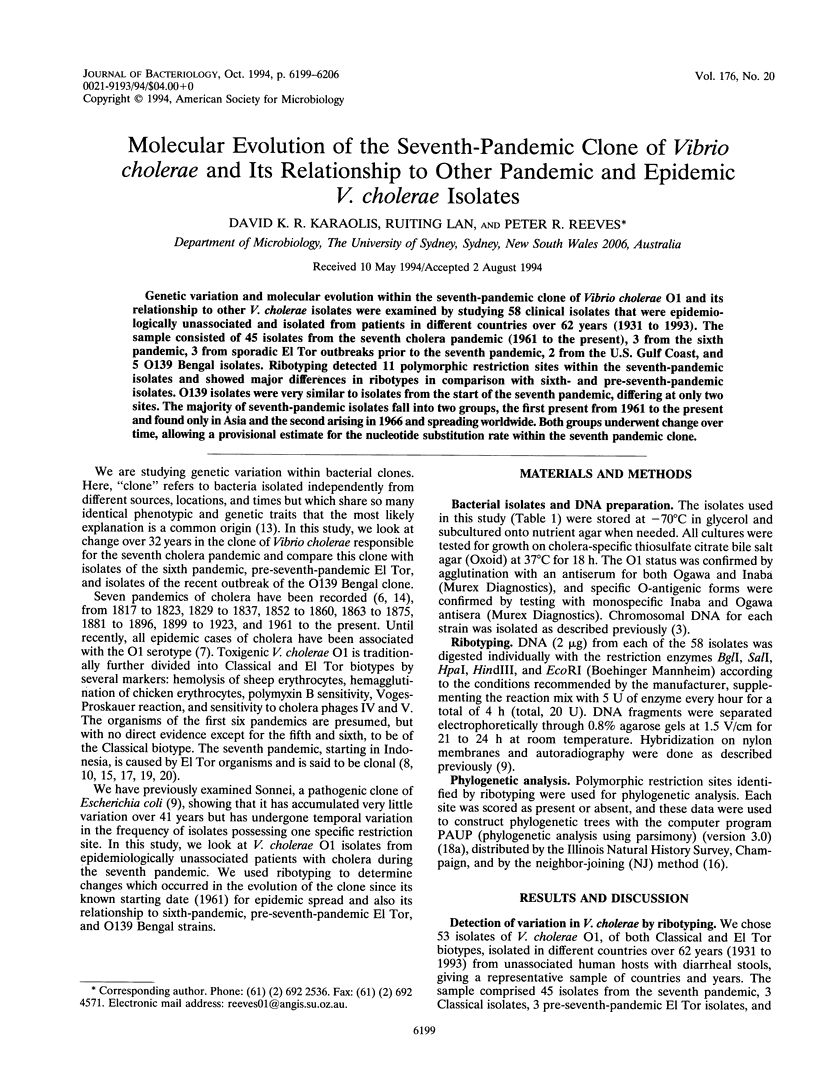Abstract
Genetic variation and molecular evolution within the seventh-pandemic clone of Vibrio cholerae O1 and its relationship to other V. cholerae isolates were examined by studying 58 clinical isolates that were epidemiologically unassociated and isolated from patients in different countries over 62 years (1931 to 1993). The sample consisted of 45 isolates from the seventh cholera pandemic (1961 to the present), 3 from the sixth pandemic, 3 from sporadic El Tor outbreaks prior to the seventh pandemic, 2 from the U.S. Gulf Coast, and 5 O139 Bengal isolates. Ribotyping detected 11 polymorphic restriction sites within the seventh-pandemic isolates and showed major differences in ribotypes in comparison with sixth- and pre-seventh-pandemic isolates. O139 isolates were very similar to isolates from the start of the seventh pandemic, differing at only two sites. The majority of seventh-pandemic isolates fall into two groups, the first present from 1961 to the present and found only in Asia and the second arising in 1966 and spreading worldwide. Both groups underwent change over time, allowing a provisional estimate for the nucleotide substitution rate within the seventh pandemic clone.
Full text
PDF







Images in this article
Selected References
These references are in PubMed. This may not be the complete list of references from this article.
- Bastin D. A., Romana L. K., Reeves P. R. Molecular cloning and expression in Escherichia coli K-12 of the rfb gene cluster determining the O antigen of an E. coli O111 strain. Mol Microbiol. 1991 Sep;5(9):2223–2231. doi: 10.1111/j.1365-2958.1991.tb02152.x. [DOI] [PubMed] [Google Scholar]
- Blake P. A., Allegra D. T., Snyder J. D., Barrett T. J., McFarland L., Caraway C. T., Feeley J. C., Craig J. P., Lee J. V., Puhr N. D. Cholera--a possible endemic focus in the United States. N Engl J Med. 1980 Feb 7;302(6):305–309. doi: 10.1056/NEJM198002073020601. [DOI] [PubMed] [Google Scholar]
- Blake P. A., Wachsmuth K., Davis B. R., Bopp C. A., Chaiken B. P., Lee J. V. Toxigenic Vibrio cholerae O1 strain from Mexico identical to United States isolates. Lancet. 1983 Oct 15;2(8355):912–912. doi: 10.1016/s0140-6736(83)90894-2. [DOI] [PubMed] [Google Scholar]
- Kaper J. B., Bradford H. B., Roberts N. C., Falkow S. Molecular epidemiology of Vibrio cholerae in the U.S. Gulf Coast. J Clin Microbiol. 1982 Jul;16(1):129–134. doi: 10.1128/jcm.16.1.129-134.1982. [DOI] [PMC free article] [PubMed] [Google Scholar]
- Karaolis D. K., Lan R., Reeves P. R. Sequence variation in Shigella sonnei (Sonnei), a pathogenic clone of Escherichia coli, over four continents and 41 years. J Clin Microbiol. 1994 Mar;32(3):796–802. doi: 10.1128/jcm.32.3.796-802.1994. [DOI] [PMC free article] [PubMed] [Google Scholar]
- Koblavi S., Grimont F., Grimont P. A. Clonal diversity of Vibrio cholerae O1 evidenced by rRNA gene restriction patterns. Res Microbiol. 1990 Jul-Aug;141(6):645–657. doi: 10.1016/0923-2508(90)90059-y. [DOI] [PubMed] [Google Scholar]
- Milkman R., Bridges M. M. Molecular evolution of the Escherichia coli chromosome. III. Clonal frames. Genetics. 1990 Nov;126(3):505–517. doi: 10.1093/genetics/126.3.505. [DOI] [PMC free article] [PubMed] [Google Scholar]
- Orskov F., Orskov I. From the national institutes of health. Summary of a workshop on the clone concept in the epidemiology, taxonomy, and evolution of the enterobacteriaceae and other bacteria. J Infect Dis. 1983 Aug;148(2):346–357. doi: 10.1093/infdis/148.2.346. [DOI] [PubMed] [Google Scholar]
- Popovic T., Bopp C., Olsvik O., Wachsmuth K. Epidemiologic application of a standardized ribotype scheme for Vibrio cholerae O1. J Clin Microbiol. 1993 Sep;31(9):2474–2482. doi: 10.1128/jcm.31.9.2474-2482.1993. [DOI] [PMC free article] [PubMed] [Google Scholar]
- Saitou N., Nei M. The neighbor-joining method: a new method for reconstructing phylogenetic trees. Mol Biol Evol. 1987 Jul;4(4):406–425. doi: 10.1093/oxfordjournals.molbev.a040454. [DOI] [PubMed] [Google Scholar]
- Salles C. A., Momen H. Identification of Vibrio cholerae by enzyme electrophoresis. Trans R Soc Trop Med Hyg. 1991 Jul-Aug;85(4):544–547. doi: 10.1016/0035-9203(91)90251-s. [DOI] [PubMed] [Google Scholar]
- Shandera W. X., Hafkin B., Martin D. L., Taylor J. P., Maserang D. L., Wells J. G., Kelly M., Ghandi K., Kaper J. B., Lee J. V. Persistence of cholera in the United States. Am J Trop Med Hyg. 1983 Jul;32(4):812–817. doi: 10.4269/ajtmh.1983.32.812. [DOI] [PubMed] [Google Scholar]
- Wachsmuth I. K., Evins G. M., Fields P. I., Olsvik O., Popovic T., Bopp C. A., Wells J. G., Carrillo C., Blake P. A. The molecular epidemiology of cholera in Latin America. J Infect Dis. 1993 Mar;167(3):621–626. doi: 10.1093/infdis/167.3.621. [DOI] [PubMed] [Google Scholar]
- Waldor M. K., Mekalanos J. J. ToxR regulates virulence gene expression in non-O1 strains of Vibrio cholerae that cause epidemic cholera. Infect Immun. 1994 Jan;62(1):72–78. doi: 10.1128/iai.62.1.72-78.1994. [DOI] [PMC free article] [PubMed] [Google Scholar]






